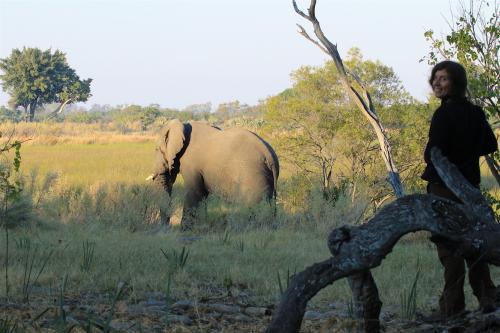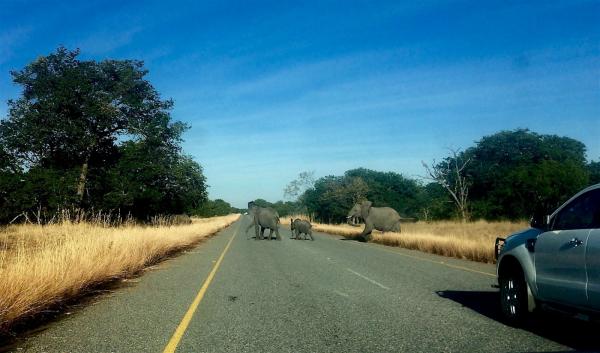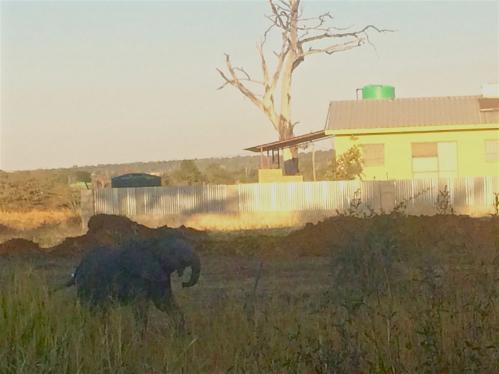
“On the count of three, everyone pull!” yelled the wildlife vet.
“He’s very heavy, and it will all be dead weight, eh.”
He counted, and I, along with eight strong men and women hauled the 6 month-old elephant calf into the back of the pickup truck. We were in the process of taking it to the place where an elephant herd had last been seen in the wildlife corridor just down the road. The calf had been cut off from its mother when the baby slipped into a lodge’s fenced campground. The calf spent hours pacing the fence, calling to its family to try to get out.
Earlier that afternoon, Elephants Without Borders (EWB), a local Non-governmental Organization, was called to the scene by the lodge staff that feared for the safety of the calf as well as their guests. I have had the great fortune of conducting my research on decision-making around human-elephant interactions with EWB this summer, and so I tagged along to see how I could help. I stood with the wildlife officers of Department of Wildlife and National Parks and watched as the lodge staff knocked down the fence and cut the barbed wire to try to let the calf out. But no sooner was the fence down that we realized that even if the calf walked over the fence, he would meet another fence in the plot next door. It hit me that this was the consequence of development in the town of Kasane: with growing human populations, new lodge developments, and more fences going up, the wildlife movements are being constrained. As a result, this calf was stuck with only one plausible way out: he would have to be transported to the wildlife corridor, where he could hopefully meet up with his family.
While helping out with this activity was useful for me to observe EWB in a time of crisis, it was a good example of the kinds of human-wildlife interactions that the people of Chobe District must deal with on a daily basis. Kasane is unique in that it is a place where people and wildlife are living together. In other cities in Botswana, fences prevent any wildlife movement, but in Kasane, you are likely to see troops of mongoose burrowing in drainage ditches, warthogs foraging in parking lots, and elephants crossing the roads. The prevalence of wildlife comes at a cost, though, for both humans and wildlife. Every year a few people lose their lives due to interactions with elephants, and an unknown amount of wildlife are hit by cars, poisoned, or harvested illegally for their meat.

I am here to research the decision-making process around human-wildlife interactions, looking at the policies and interviewing decision-makers to see how they view the challenges and benefits of living with wildlife. I have spoken to community members, government officials, NGOs, religious leaders, local leaders, and participants from the private sector to hear their takes on these issues and gather their recommended solutions. One huge theme has been the importance of land use planning. EWB has been instrumental in designating wildlife corridors in town that connect elephants and many other species from the Forest Reserve and Chobe National Park to the Chobe River. Moving forward, Kasane will need to maintain and protect these pathways so that there is still space for wildlife here.
In addition to the interviews I have conducted, I have also had the amazing opportunity to observe many of EWB’s activities: from collaring elephants to monitor their movements; to participating in IKOVA, a community driven program that promotes human-wildlife coexistence, conservation culture, and healthy communities; to speaking with nearby farming communities to understand their thoughts on wildlife movements and conflict animals. Besides this, EWB surveys wildlife populations in Botswana, Zambia, Zimbabwe, Namibia, and Angola, and recently just concluded the Great Elephant Census, which counted all of the African elephants left in the elephant range. Spending this time with them has shown me that a small NGO has the power to accomplish much by applying ecological knowledge to help promote positive human-wildlife coexistence.
As I wrap up my last week of interviews in Kasane, I am looking forward to speaking with the government officials in the capital, pausing to absorb all I have learned along the way, and reflecting back on that elephant caught in the fence.
I remember climbing into the back of the truck, standing just inches from the baby elephant’s head, and monitoring its breathing. A few minutes later, we unloaded the calf in the corridor. It looked at us and raised its trunk, then turned and headed towards a family herd of elephants just meters away, standing in the moonlight.
